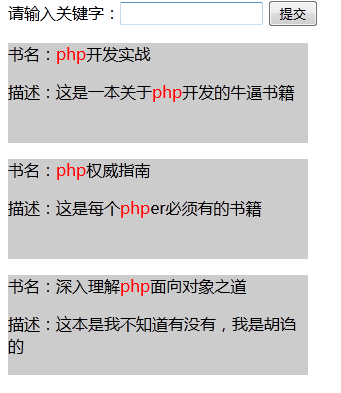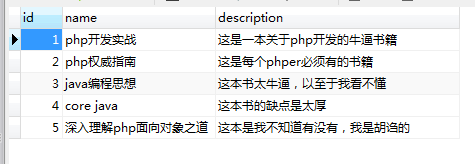How to use keyword query written in php
How to write keyword query in PHP: first get the keyword text input from the text box; then connect to the database to query, and query the records containing the keyword text in the book title or description; finally Just display the query results in a loop.

The operating environment of this article: windows7 system, PHP7.1 version, DELL G3 computer
How to write keyword query in php ?
PHP realizes the highlight function after keyword search:
When I first started learning PHP, I was curious about the keyword highlight after search, but in the past few days, I have consolidated it. When I learned the basics of PHP, I found that it was not difficult to achieve such an effect. As usual, let me show you the renderings first.
Running renderings

Database related
- The database name is Book has only one database table, which is also a book, and simulates 5 pieces of data.
- The name field is the title of the book, and the description field is the description of the book

##Code
<!DOCTYPE html>
<html>
<head>
<meta charset="utf-8">
<meta http-equiv="X-UA-Compatible" content="IE=edge">
<title></title>
<link rel="stylesheet" href="">
</head>
<body>
<form action="14.php" method="post">
请输入关键字:<input type="text" name="keyword">
<input type="submit" value="提交" />
</form>
<?php
if(!empty($_POST['keyword'])){
$keyword = $_POST['keyword'];//获取输入的关键字
//进行数据库连接
$conn = mysql_connect("localhost","root","1234");
if(!$conn){
die("数据库连接失败");
}
$flag = mysql_select_db("book",$conn);
if(!$flag){
die("数据库打开失败");
}
mysql_query("set names utf8");
$sql = "select * from book where name like '%$keyword%' or description like '%$keyword%'";
$result = mysql_query($sql,$conn);
while($row = mysql_fetch_assoc($result)){
?>
<p style="width:300px;height:100px;background-color: #ccc;margin-bottom: 10px">
<p>书名:<?php echo str_ireplace($keyword, "<font color='#f00'>$keyword</font>",$row['name'])?></p>
<p>描述:<?php echo str_ireplace($keyword, "<font color='#f00'>$keyword</font>",$row['description'])?></p>
</p>
<?php
}
}else{
echo "很遗憾,没有找到书籍";
}
?>
</body>
</html>str_ireplace() function to replace the keyword text with red text to achieve the effect of keyword highlighting.
PHP Video Tutorial"
The above is the detailed content of How to use keyword query written in php. For more information, please follow other related articles on the PHP Chinese website!

Hot AI Tools

Undresser.AI Undress
AI-powered app for creating realistic nude photos

AI Clothes Remover
Online AI tool for removing clothes from photos.

Undress AI Tool
Undress images for free

Clothoff.io
AI clothes remover

AI Hentai Generator
Generate AI Hentai for free.

Hot Article

Hot Tools

Notepad++7.3.1
Easy-to-use and free code editor

SublimeText3 Chinese version
Chinese version, very easy to use

Zend Studio 13.0.1
Powerful PHP integrated development environment

Dreamweaver CS6
Visual web development tools

SublimeText3 Mac version
God-level code editing software (SublimeText3)

Hot Topics
 CakePHP Project Configuration
Sep 10, 2024 pm 05:25 PM
CakePHP Project Configuration
Sep 10, 2024 pm 05:25 PM
In this chapter, we will understand the Environment Variables, General Configuration, Database Configuration and Email Configuration in CakePHP.
 PHP 8.4 Installation and Upgrade guide for Ubuntu and Debian
Dec 24, 2024 pm 04:42 PM
PHP 8.4 Installation and Upgrade guide for Ubuntu and Debian
Dec 24, 2024 pm 04:42 PM
PHP 8.4 brings several new features, security improvements, and performance improvements with healthy amounts of feature deprecations and removals. This guide explains how to install PHP 8.4 or upgrade to PHP 8.4 on Ubuntu, Debian, or their derivati
 CakePHP Date and Time
Sep 10, 2024 pm 05:27 PM
CakePHP Date and Time
Sep 10, 2024 pm 05:27 PM
To work with date and time in cakephp4, we are going to make use of the available FrozenTime class.
 CakePHP File upload
Sep 10, 2024 pm 05:27 PM
CakePHP File upload
Sep 10, 2024 pm 05:27 PM
To work on file upload we are going to use the form helper. Here, is an example for file upload.
 CakePHP Routing
Sep 10, 2024 pm 05:25 PM
CakePHP Routing
Sep 10, 2024 pm 05:25 PM
In this chapter, we are going to learn the following topics related to routing ?
 Discuss CakePHP
Sep 10, 2024 pm 05:28 PM
Discuss CakePHP
Sep 10, 2024 pm 05:28 PM
CakePHP is an open-source framework for PHP. It is intended to make developing, deploying and maintaining applications much easier. CakePHP is based on a MVC-like architecture that is both powerful and easy to grasp. Models, Views, and Controllers gu
 CakePHP Creating Validators
Sep 10, 2024 pm 05:26 PM
CakePHP Creating Validators
Sep 10, 2024 pm 05:26 PM
Validator can be created by adding the following two lines in the controller.
 CakePHP Working with Database
Sep 10, 2024 pm 05:25 PM
CakePHP Working with Database
Sep 10, 2024 pm 05:25 PM
Working with database in CakePHP is very easy. We will understand the CRUD (Create, Read, Update, Delete) operations in this chapter.






